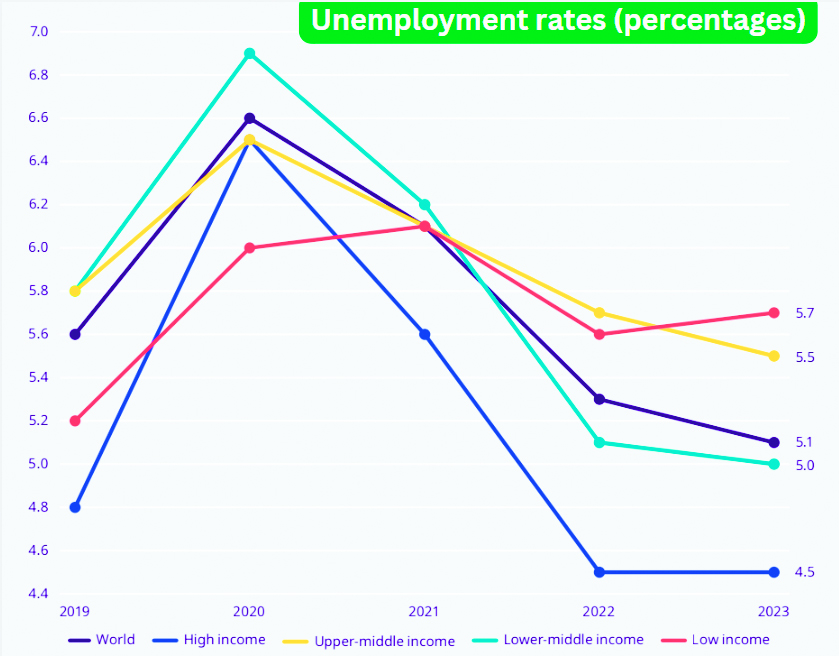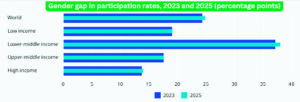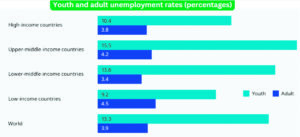
The International Labour Organization’s World Employment and Social Outlook Trends 2024 report reveals that slightly more than five per cent of the global workforce is currently unemployed. While this represents an improvement compared to the situation before the pandemic, the positive trend is anticipated to be short-lived.

The ILO predicts that an additional two million individuals will be seeking employment in the next 12 months, signalling potential challenges on the horizon.
The conclusions drawn by the UN agency align with a recent World Bank report, revealing that the global economy is heading towards its slowest half-decade of growth in 30 years.
The International Labour Organization (ILO) further highlighted, in addition to the uncertain job market outlook, that a significant number of the world’s wealthiest nations have witnessed a decline in living standards attributed to inflation. Although inflation is now receding in many major economies, the ILO emphasized that the erosion of living standards is unlikely to be swiftly compensated.

Big disparities
ILO experts emphasize substantial disparities between higher and lower-income countries. In 2023, the jobs gap rate, indicating the percentage of jobless individuals seeking work, was 8.2 per cent in wealthier nations, contrasting with 20.5 per cent in less affluent countries. Likewise, the unemployment rate in 2023 remained at 4.5 per cent for affluent nations, while it was 5.7 per cent for low-income countries.
ILO Director-General Gilbert Houngbo cautioned that the combination of declining living standards, weak productivity, and persistent inflation sets the stage for increased inequality, undermining endeavours to attain social justice.
He stressed that without enhanced social justice, a sustainable recovery is unattainable. Houngbo called for swift and effective measures to address workforce challenges comprehensively.
The working poor
Global unemployment is projected to increase in 2024 by around 2 million. The modest increase in the unemployment rate will translate into an increase in global unemployment of 2 million in 2024, rising to 190.8 million from 188.6 million in 2023.
The outlook for unemployment in 2024 is broadly consistent across income groups, with each country group being expected to see an increase in unemployment. The increase is expected to be highest (1 million in total) in high-income countries.
Despite quickly declining after 2020, the number of workers living in extreme poverty (earning less than US$2.15 per person per day) grew by about a million in 2023.
Decent work deficits persist, with considerable heterogeneity across regions and groups. The decline in unemployment rates obscures a significant lack of decent employment opportunities. The jobs gap stood at nearly 435 million in 2023, representing a jobs gap rate of 11.1 per cent.
Moreover, many individuals in employment are confronted with several barriers to decent work, including declining real wages, elevated levels of informal employment and deteriorating working conditions. In other instances, barriers to labour market participation persist, notably for women, and for youth, who also continue to be confronted with higher levels of unemployment.
Together, these factors are undermining long-run progress to improving decent work and social justice. Gender gaps in participation rates will persist. Over the forecast period, both male and female participation rates are expected to decline. Since the decline among women is anticipated to be more pronounced than that among men, the gender gap in participation rates will rise modestly.
In 2025, the global participation rates of men will exceed those of women by 25 percentage points (the gap will be noticeably elevated, at 38 percentage points, in lower-middle-income countries). Youth unemployment rates are nearly 3.5 times higher than those of adults. Globally, in 2023, the youth unemployment rate, 13.3 per cent, far exceeded that of adults, 3.9 per cent.
The general pattern of higher youth unemployment holds across all country income groups. Uppermiddle-income countries had the highest youth unemployment rate, 15.5 per cent, in 2023.
Income inequality has also widened, the trends show: the erosion of real disposable income, “bodes ill for aggregate demand and a more sustained economic recovery”, notes the report.
Despite various policy initiatives to tackle the underground economy, the number of people employed informally is expected to remain static, accounting for around 58 per cent of the global workforce in 2024.
Uneven post-pandemic recovery
The World Health Organization (WHO) declared an end to COVID-19 as a public health emergency last May, but the aftershocks of the pandemic are still being felt, the ILO report reveals.
Residual symptoms and health problems for those 20 per cent or so who suffered ‘long COVID’ persist for many and have impacted productivity.
Many who have re-entered the labour market post-pandemic tend not to be working the same number of hours while the number of sick days taken has increased significantly.
Women’s participation in the job market has bounced back quickly, but a notable gender gap persists, especially in emerging and developing nations. Youth unemployment rates continue to present a challenge.
The report also finds that despite technological advances and increased investment, productivity growth has continued to slow.
In conclusion, the International Labour Organization’s World Employment and Social Outlook Trends 2024 report paints a nuanced picture of the global job market in the aftermath of the COVID-19 pandemic. While the current unemployment rate of just over five per cent represents an improvement from pre-pandemic levels, concerns loom on the horizon. Projections indicate that an additional two million people may join the job market over the next 12 months, contributing to an overall increase in global unemployment.
In navigating the post-pandemic landscape, policymakers are urged to address the identified challenges promptly and effectively to ensure a sustainable and equitable recovery. The report serves as a call to action, emphasizing the importance of prioritizing social justice, reducing inequality, and fostering decent work opportunities worldwide.